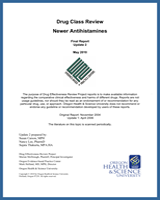Key Question 1. Comparative efficacy
For outpatients with seasonal or perennial allergic rhinitis or urticaria, do newer antihistamines differ in effectiveness? |
| Adults |
| Seasonal allergic rhinitis (SAR) | Fair for efficacy (symptoms)
Fair to poor for quality of life | Eleven short-term trials showed no significant difference in comparisons of cetirizine to fexofenadine and loratadine, fexofenadine to loratadine and desloratadine, levocetirizine to loratadine, and azelastine nasal spray to desloratadine and olopatadine nasal spray.
Two fair-quality trials found azelastine nasal spray superior to oral cetirizine for reduction in symptoms and quality of life.
Quality of life was better with fexofenadine than loratadine in 1 study. |
| Perennial allergic rhinitis (PAR) | Fair for comparisons of levocetirizine to loratadine and desloratadine.
Insufficient for other comparisons. | Two head-to-head trials showed no significant difference in reduction in symptoms with levocetirizine compared with loratadine and desloratadine.
Two 6-month trials of levocetirizine 5 mg showed improved quality of life at 6 months relative to placebo.
Ten placebo-controlled trials demonstrated efficacy for azelastine nasal spray, cetirizine, desloratadine, levocetirizine, and loratadine, but did not provide information about comparative effectiveness. |
| Chronic idiopathic urticaria (CIU) | Fair to poor for comparisons of cetirizine to fexofenadine, levocetirizine, and loratadine.
Fair for comparison of levocetirizine to desloratadine.
Insufficient for other comparisons. | Loratadine was superior to cetirizine for reduction in symptoms in 2 fair-quality trials. Response (defined as asymptomatic) rates were higher with loratadine, but the differences were not statistically significant.
Levocetirizine was superior to desloratadine for symptom reduction in 1 trial, but there was no difference between drugs in quality-of-life scores.
Cetirizine was more efficacious than fexofenadine in 1 trial limited by a high dropout rate and no intention-to-treat analysis. |
| Other urticaria | No fair- or good-quality evidence identified | No available data on comparative effectiveness in other types of urticaria. |
| Children |
| Seasonal allergic rhinitis (SAR) | Poor for comparative effectiveness | Ten fair-quality placebo-controlled and active-control studies.
No head-to-head studies. |
| Perennial allergic rhinitis (PAR) | Fair for comparison of cetirizine to loratadine in children ages 2 to 6 years.
Fair for comparison of cetirizine to levocetirizine in children ages 6 to 12 years. | One fair-quality study suggested cetirizine may be more efficacious than loratadine.
Cetirizine was superior to levocetirizine for symptoms in 1 fair-quality study, but there was no difference in quality of life.
Insufficient evidence on the comparative effectiveness of other drug combinations. |
| Urticaria | Poor for comparative effectiveness | No head-to-head studies. |
Key Question 2. Harms
For outpatients with Seasonal allergic rhinitis, Perennial allergic rhinitis or urticaria, do newer antihistamines differ in safety or adverse effects? |
| Overall adverse events | Fair | Rates of discontinuation due to adverse events was low with included newer antihistamines. |
| Sedation | Fair | First-generation antihistamines (diphenhydramine, chlorpheniramine) more sedating than newer-generation agents.
Cetirizine and levocetirizine were more sedating than loratadine and desloratadine.
Some evidence suggested that cetirizine may be more sedating than fexofenadine.
There was no significant difference in reports of sedation between loratadine and fexofenadine in 1 observational study. |
| Headache | Fair | Headache was reported with similar rates in cetirizine, loratadine, and fexofenadine. |
| Cardiac effects | Fair | A large, fair-quality cohort study provided evidence of a significant risk of cardiac arrhythmias with cetirizine compared with non-use. A nonsignificant increase in risk was noted with loratadine.
Limited evidence suggested no QTc prolongation with loratadine and fexofenadine. |
| Bitter taste/nasal discomfort | Fair | Incidence was higher with azelastine than olopatadine in head-to-head trials but indirect assessment suggested minimal difference between groups. |
| Children | No head-to-head data on adverse events except 2 events in cetirizine group (vs. loratadine)
Overall, Fair | Insufficient evidence on comparative safety.
Newer antihistamines were well-tolerated in this population with little withdrawal due to adverse events.
Fair-quality evidence on the safety of cetirizine and loratadine.
Limited evidence on the safety of desloratadine and fexofenadine.
Fair evidence that cetirizine does not significantly prolong QTc interval.
Limited evidence (1 study each) that desloratadine and fexofenadine did not prolong QTc interval. |
Key Question 3. Subgroups
Are there subgroups of patients based on demographics (age, racial groups, gender), concomitant medications (drug-drug interactions), co-morbidities (drug-disease interactions or pregnancy), for which one newer antihistamine is more effective or associated with fewer adverse effects? |
| Age, gender, race/ethnicity | There was insufficient evidence to determine whether any of the antihistamines examined in this report has an advantage in efficacy or safety for any group based on sex, race/ethnicity, or age. | We did not identify head-to-head comparative studies of drug interactions. |
| Asthma or atopic dermatitis | Fair | There were no differences in rate of adverse events in patients with allergic rhinitis and asthma or atopic dermatitis. |
| Pregnancy | Fair | There was minimal increase risk of birth defects observed with newer antihistamines in pregnant women.
Newer antihistamine drug exposure in pregnant women did not significantly increase the risk of hypospadias in male infants. |
